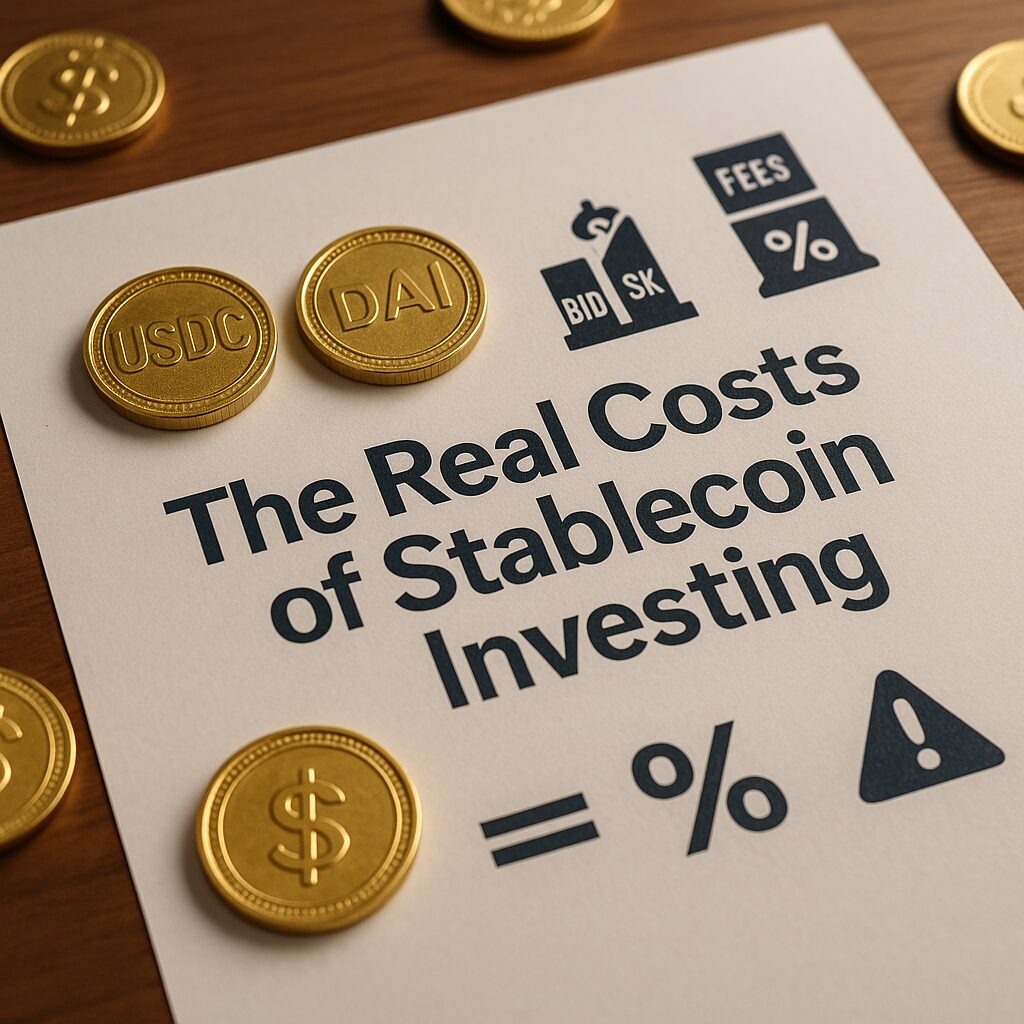At first glance, stablecoin investing seems simple: 1 USDC = $1, right? But beneath that reassuring peg lies a complex web of hidden costs that can quietly eat away at your profits — especially if you’re chasing yield across different platforms or blockchains. In this guide, we’ll break down the real costs involved in stablecoin investing so you can protect your earnings and avoid costly mistakes.
Table of Contents
- Introduction – The Illusion of Simplicity
- Spread: The Silent Profit Killer
- Blockchain Fees: Ethereum vs. Tron vs. Solana
- Deposit & Withdrawal Fees on CeFi Platforms
- Slippage and Impermanent Loss in DeFi
- Smart Contract Risks and Emergency Withdrawals
- “Peg Risk”: What Happens If a Stablecoin Breaks
- Comparing Real Net Yield After All Costs
- Case Study: Yield vs. Hidden Costs
- Final Checklist Before You Invest
1. Introduction – The Illusion of Simplicity
Stablecoins are marketed as safe, stable, and easy to use — perfect for those new to crypto. But when you start using them to earn yield, you’ll quickly find that “$1 in” rarely equals “$1 out”.
From gas fees and trading spreads to obscure platform charges, the true cost of investing can be surprisingly high. And unlike typical investment fees, many of these costs aren’t clearly disclosed.
2. Spread: The Silent Profit Killer
Even on reputable exchanges, the bid-ask spread can quietly drain your capital. For example, you may think you’re buying 1000 USDT at $1.00, but the actual price is $1.003 — and when selling, you may only get $0.997.
That’s a $6 loss per $1,000 round-trip — without even considering other fees.
In low-volume exchanges or when using fiat conversion, spreads can be as high as 0.5%–1%.
3. Blockchain Fees: Ethereum vs. Tron vs. Solana
Every transfer comes with a network fee, and it varies wildly by chain:
- Ethereum: High gas fees; $5–$50 for a single transfer
- Tron (TRC20): Often free or under $1
- Solana: Extremely low, under $0.01
These fees add up fast when you’re transferring between wallets, platforms, or even performing DeFi actions.
Tip: Use Tron or Solana for routine transfers, and reserve Ethereum for DeFi interactions that require it.
4. Deposit & Withdrawal Fees on CeFi Platforms
Centralized platforms often charge additional:
- Deposit fees (crypto or fiat)
- Stablecoin conversion fees (e.g., USDC → USDT)
- Withdrawal fees (flat or % based)
Some platforms even deduct a percentage of your yield as a “platform fee.” Always read the fine print.
5. Slippage and Impermanent Loss in DeFi
If you’re using DEXs or AMMs like Uniswap, slippage can result in actual price execution worse than expected. This happens during volatile moments or large trades.
Liquidity pools (e.g., USDC-DAI) also introduce impermanent loss, especially when the peg is unstable or volume is low.
6. Smart Contract Risks and Emergency Withdrawals
In DeFi platforms, withdrawing funds prematurely due to fear or emergency may incur:
- Penalties (early withdrawal fees)
- “Unstaking” or unlocking delays
- Platform congestion during market stress
You should also consider the security audit status of any DeFi protocol — hacks can erase your investment overnight.
7. “Peg Risk”: What Happens If a Stablecoin Breaks
Stablecoins rely on different mechanisms to stay pegged:
- Fiat-backed (USDC, USDT): Reserve transparency is key
- Crypto-collateralized (DAI): Volatility of collateral can affect peg
- Algorithmic (UST, AMPL): Highly risky, often fail in market crashes
Even a 2–3% deviation from the $1.00 peg can trigger liquidation in leveraged positions or cause panic exits.
8. Comparing Real Net Yield After All Costs
Let’s say you earn 10% APY on a platform like Nexo or Curve. After costs:
- Blockchain fees: -1.5%
- Spreads on buy/sell: -1.2%
- Withdrawal fee: -0.5%
- Yield platform fee: -0.8%
Net yield: ~6% — if you’re lucky.
That’s a 40% cut to your expected profit due to hidden costs.
9. Case Study: Yield vs. Hidden Costs
Investor Profile:
Alice deposits $5,000 USDC into a CeFi platform offering 12% APY.
- Initial deposit fee: $25
- Transfer fee (ETH): $12
- Yield platform charges 1.5% of earnings
- After 12 months, she earns $600 in gross interest
- Net return after all fees: $490 → Real APY: 9.8%
Now compare this with a low-fee DeFi strategy where fees are under $20 total. The difference in returns grows over time.
10. Final Checklist Before You Invest
Before locking up your stablecoins:
Compare APY after all fees
Check withdrawal terms (are they instant?)
Understand the chain fees
Research the stablecoin’s peg history
Avoid platforms with vague or hidden charges
Prefer audited smart contracts for DeFi
📌 Coming Up Next
How to Legally Maximize Stablecoin Returns Without Violating Tax or Compliance Rules
→ In our next post, we’ll explore how to manage your stablecoin income without triggering tax or legal issues — from tracking tools to platform documentation.
